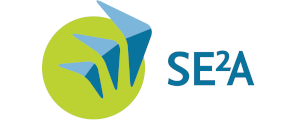
The project ICA B3.1 aims to develop an additively manufactured, multifunctionally graded, triply periodic minimal surface wing leading edge with hybrid laminar flow control functionality resistant to high velocity impact bird strike loading.
Almost the entire wetted surface of today's commercial aircraft has a turbulent boundary layer. As a turbulent boundary layer results in viscous drag five to ten times larger than that of laminar boundary layers, hybrid laminar flow control (HLFC) has proven to be an efficient mean for drag reduction. In this approach, HLFC consists of laminar flow control (LFC) by boundary layer suction in the leading edge (LE) and natural laminar flow (NLF) by a smooth surface in the rear part of the wing. Due to the orientation in flight direction, the leading edge has to sustain high velocity impact (HVI) loads such as bird strike that may occur during flight. The general design goal is to absorb all the HVI energy within the leading edge structure to maintain structural integrity of the front spar as a main load carrying member.
In regard to multifunctional, lightweight design, the leading edge structure is aimed to be made out of a triply periodic minimal surface (TPMS) structure, a cellular structure, that embodies a high specific energy absorption (SEA) and the capabilitiy to enable suction for LFC. TPMS structures will be investigated regarding their functional and mechanical properties. The goal is to functionally and mechanically optimise graded TPMS structures for a leading edge design that fulfills safety aspects and requirements for HLFC.
Institut für Flugzeugbau und Leichtbau (IFL)
Institute of Aircraft Design and Lightweight Structures
TU Braunschweig
Hermann-Blenk-Str. 35
D-38108 Braunschweig
Institut für Faserverbundleichtbau und Adaptronik (DLR-FA)
Institute of Lightweight Systems and Composite Design
Deutsches Zentrum für Luft- und Raumfahrt (DLR)
Lilienthalplatz 7
D-38108 Braunschweig